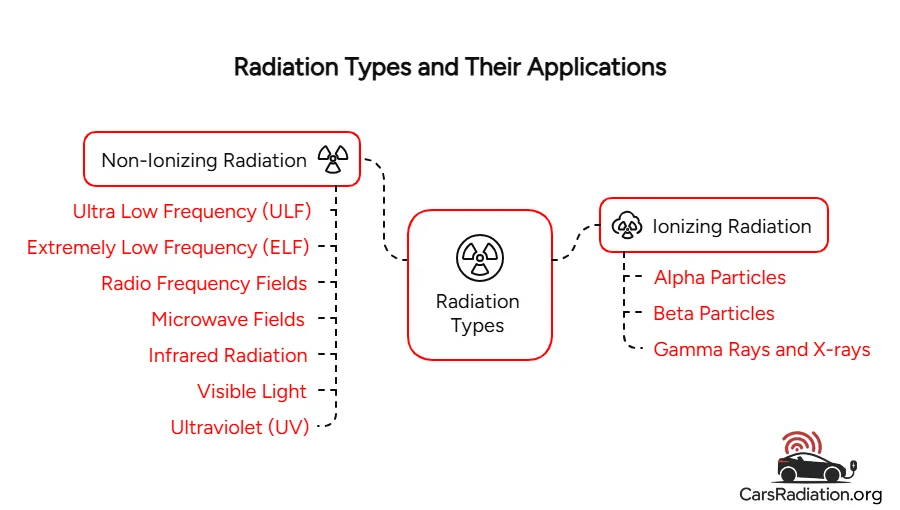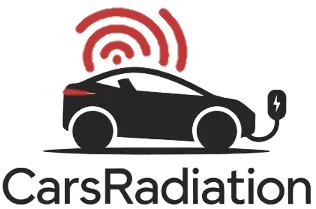What is Radiation

Radiation is an inherent aspect of both the physical universe and engineered systems. It exists across scales (cosmic to biological) and plays an important function in numerous applications.
This ranges from environmental phenomena (e.g., solar energy) to applied technologies such as medical diagnostics and wireless communication.
The relevance of radiation to health and safety continues to adapt as new sources, including those found in modern electric vehicles, become more prevalent.
This document aims to provide a technical overview of radiation, including its classification, physical characteristics, origin, and known biological interactions with particular attention to low-frequency electromagnetic fields.
Definition and Classification
Radiation is defined as the transmission of energy through space or material media. It can be categorized according to the nature of the energy carrier and the mechanism of propagation. Two primary forms are commonly recognized:
1. Electromagnetic Radiation (EMR)
A spectrum of wave-based phenomena including visible light, radiofrequency (RF), microwave, infrared, ultraviolet (UV), X-ray, and gamma radiation. EMR does not require a physical medium and propagates via oscillating electric and magnetic fields at the speed of light in vacuum.
2. Particle Radiation
Comprises discrete particles such as alpha (helium nuclei), beta (electrons or positrons), and neutron emissions. This form of radiation typically originates from radioactive decay processes and nuclear interactions.
Terminology and Parameters
- Frequency (Hz): Indicates the number of oscillations per second. In EMR, frequency is directly proportional to energy (E = hf, where h is Planck’s constant).
- Wavelength (λ): The spatial period of the wave, inversely proportional to frequency (c = λf, where c is the speed of light).
- Ionizing vs. Non-Ionizing Radiation: An important distinction based on the energy threshold necessary to ionize atoms or molecules. Ionizing radiation (X-rays, gamma rays, etc.) can break molecular bonds and directly damage DNA. Non-ionizing radiation (e.g., RF, ELF) lacks sufficient energy per photon to ionize, but may induce other biological effects, including those associated with long-term exposure to alternating magnetic fields.
Radiation Types
Ionizing Radiation
Ionizing radiation refers to radiation with sufficient energy to displace tightly bound electrons from atoms, leading to the formation of ions. This category includes:
- Alpha particles – Heavily charged, low-penetration particles consisting of two protons and two neutrons. Typically stopped by a sheet of paper or skin.
- Beta particles – Lighter, high-velocity electrons or positrons capable of penetrating several millimeters into tissue.
- Gamma rays and X-rays – Electromagnetic radiation at high frequencies. Notably penetrating and commonly used in diagnostic and therapeutic applications.
These radiation forms are extensively utilized in clinical oncology, radiographic imaging, and nuclear generation. However, their energy levels pose biological risks, particularly with chronic or unshielded exposure, resulting in potential DNA disruption and cellular degradation.
Non-Ionizing Radiation
 Non-ionizing radiation does not possess sufficient photon energy to ionize atoms. The electromagnetic spectrum below ultraviolet light comprises the following:
Non-ionizing radiation does not possess sufficient photon energy to ionize atoms. The electromagnetic spectrum below ultraviolet light comprises the following:
- Ultra low frequency (ULF) – Common sources include electrical wiring, electric motors, and vehicle powertrain systems (especially in EVs and hybrids). This band overlaps with Extremely Low Frequency (ELF).
- Extremely Low Frequency (ELF) – Found in power lines, household appliances, and electric transportation systems.
- Radio frequency fields – Emitted from communication transmitters, including AM/FM radios and cellular towers.
- Microwave fields – Present in consumer appliances and wireless communication infrastructure.
- Infrared radiation – Common in thermal sources and sensor systems.
- Visible light – Occupying the narrow spectrum detectable by the human eye.
- Ultraviolet (UV) – Notably, UV-A and UV-B are non-ionizing; UV-C borders the ionizing threshold depending on photon energy and context.
These fields are omnipresent in modern environments. Their prevalence spans telecommunications, industrial automation, consumer electronics, and transportation systems.

Radiation Sources
Natural Radiation
Natural background radiation originates from both extraterrestrial and terrestrial processes:
- Cosmic radiation – High-energy particles from solar and galactic sources. Exposure intensity correlates with altitude and geomagnetic latitude.
- Terrestrial radiation – Emission from radionuclides in geological formations, notably uranium-238, thorium-232, and their decay products such as radon gas.
- Internal exposure – Resulting from naturally occurring isotopes within biological systems, such as potassium-40 and carbon-14.
Cumulative exposure from these sources constitutes a baseline level of radiation experienced globally, varying with geography and lifestyle.
Anthropogenic Radiation
Human-generated radiation arises from technological and industrial practices:
- Medical diagnostics and therapy – Including X-ray imaging, fluoroscopy, computed tomography (CT), and linear accelerators used in radiotherapy.
- Industrial applications – Non-destructive testing, material irradiation, and instrument sterilization.
- Energy production – Nuclear fission in power reactors and associated fuel cycle activities.
These sources, while controlled under regulatory frameworks, represent a substantial portion of an individual’s cumulative radiation exposure in developed environments.
Radiation in Automotive Systems
 Contemporary vehicles, especially those incorporating electric and hybrid electric propulsion, introduce additional exposure pathways to low-frequency non-ionizing electromagnetic fields (EMFs). Principal contributors include:
Contemporary vehicles, especially those incorporating electric and hybrid electric propulsion, introduce additional exposure pathways to low-frequency non-ionizing electromagnetic fields (EMFs). Principal contributors include:
- Traction system components – High-current conductors, power inverters, and electric motors generate alternating magnetic fields primarily in the tens to hundreds of hertz range.
- Onboard wireless systems – Bluetooth, Wi-Fi, GPS, and tire pressure monitoring systems (TPMS) contribute to increased RF field presence.
- Charging infrastructure – Notably during fast DC charging sessions, transient current flow and switching activity result in localized peaks in field intensity.
Empirical assessments reveal considerable spatial variability in magnetic field strength within vehicle cabins. Factors include powertrain layout, shielding effectiveness, and proximity to emission sources.
Populations such as pregnant women and children may warrant special consideration, given their increased sensitivity to biologically active low-frequency fields and anatomical proximity during typical seating positions.
Radiation is energy in the form of waves or particles traveling through space or materials, and for EMF concerns, companies like Noradiation.ca offer testing and mitigation services.
Mechanisms of Radiation Interaction
The interaction of electromagnetic radiation with matter occurs through three principal physical mechanisms:
- Penetration – Defined as the ability of radiation to traverse a given medium. This property is directly correlated to the radiation’s energy and the material’s density and composition.
- Absorption – A process in which the energy of the radiation is transferred to the medium, often resulting in thermal elevation or, in the case of sufficiently energetic photons, ionization of atoms or molecules.
- Scattering – Refers to the redirection of radiation paths due to collisions with atoms, molecules, or particulate structures within the material.
Ionizing radiation, characterized by energy levels sufficient to disrupt chemical bonds, is well-documented in inducing molecular damage, particularly to DNA. Non-ionizing radiation, though of lower energy, is not inert; its interaction mechanisms include vibrational excitation and dielectric heating, with evidence suggesting potential impacts on biological function.
Biological Effects and Health Implications
Ionizing Radiation
Exposure to ionizing radiation introduces quantifiable risk, both in acute and long-term contexts. These effects are energy-dose dependent and include:
- Acute Effects – Tissue-level damage such as dermal burns and hematopoietic suppression commonly associated with high-dose events.
- Chronic Effects – Increased incidence of malignancies, hereditary effects, and genomic instability following protracted or repeated exposures at sub-lethal levels.
Non-Ionizing Radiation
Although non-ionizing fields lack the quantum energy required for ionization, emerging evidence points to physiological and cellular responses under prolonged exposure conditions:
- Thermal Mechanisms – Localized heating phenomena resulting from energy deposition, exemplified in microwave and radiofrequency domains.
- Non-Thermal Mechanisms – Biological responses that are not temperature-mediated, such as perturbation of cellular signaling pathways, induction of heat-shock proteins, and increased oxidative stress markers.
Contextual Application: Electrified Vehicle Environments
Electric and hybrid vehicles introduce a persistent exposure environment to extremely low frequency (ELF) magnetic fields, primarily generated by propulsion systems and high-current power electronics. The ELF spectrum relevant to vehicle emissions typically spans the 1–300 Hz range.
Noteworthy findings include:
- Spatial Distribution – Peak field intensities measured proximate to footwells and second-row passenger compartments, correlating with proximity to cable routing and motor inverters.
- Health Concerns – Observational and epidemiological studies have suggested possible associations between chronic ELF exposure and Increased risks for neurological disorders and malignancies, particularly in scenarios of cumulative exposure such as daily commuting.
While measured field levels generally reside within contemporary regulatory frameworks (e.g., ICNIRP), the precautionary principle, as advocated by the WHO, underscores the importance of exposure minimization and continued scientific assessment.
Radiation Protection and Safety Measures
Mitigation of radiation exposure (ionizing or non-ionizing) requires an integrative plan which includes technical design, regulatory enforcement, and user behavior.
Core Protective Strategies
- Time, Distance, Shielding – Classical radiation safety principles remain applicable. Exposure duration reduction, spatial separation, and incorporation of attenuating materials are foundational to risk control.
- Engineering Controls – In vehicular contexts, active field cancellation technologies such as those developed by SafeFields introduce phase-inverted magnetic waveforms to suppress net field intensity in passenger zones.
Regulatory and Institutional Framework
- ICNIRP Guidelines – These define acceptable exposure thresholds for occupational and general public scenarios to provide a benchmark for compliance evaluation. However, numerical field level limits (reference levels) are suggested only for an acute type of exposure, due to complexity of setting the exact target levels for chronic exposure.
- WHO guidelines and the precautionary principle
The World Health Organization (WHO), through its Environmental Health Criteria Monograph No. 238 and related statements, has recognized the ongoing scientific uncertainty surrounding chronic exposure to extremely low-frequency magnetic fields (ELF-MF). The WHO supports the application of the precautionary principle, especially in light of epidemiological evidence suggesting an increased incidence of childhood leukemia at average residential exposure levels above 0.3–0.4 µT (3–4 mG). These findings are primarily derived from pooled analyses of multiple population studies and form the basis for several precautionary policy recommendations.
- China-NCAP EMF Grading – The Green New Car Assessment Program includes dedicated EMF testing protocols and assigns safety grades to vehicles based on in-cabin magnetic field levels.
- Policy Development and Public Awareness – Broader policy efforts target standardization of testing protocols, vehicle design considerations, and dissemination of educational material to stakeholders. An example of a recently ratified testing protocol is the IEC 62764.

